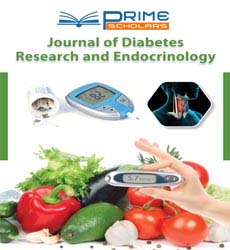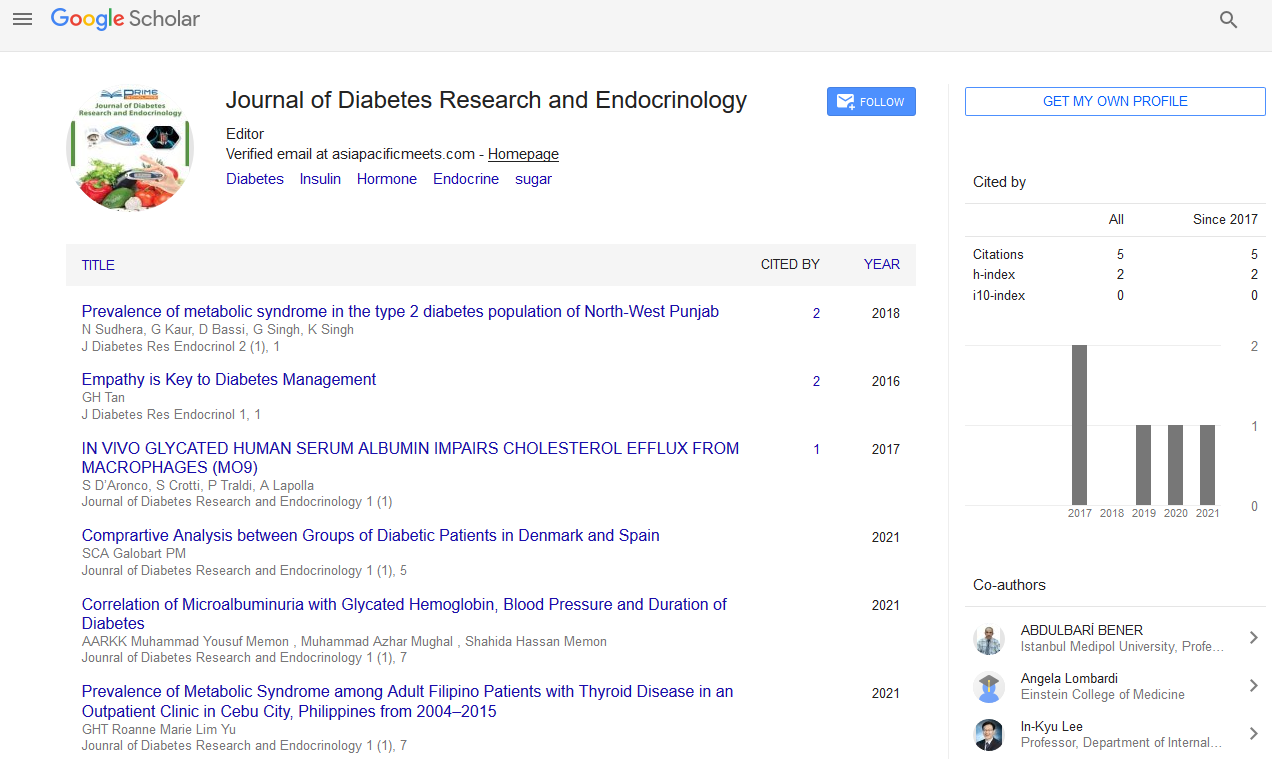Review Article - (2023) Volume 7, Issue 3
Natural Management Modalities in a Newly Diagnosed Diabetic Patient: A Review
Amr IM Hawal1*,
Wafaa MS Hegab2,
Fatma ElZahraa T Hussin3,
Sherif MH Gad3,
Gehan IM Mohamed4,
Malak A Alia5,
Amr MM Amr6,
Ahmed Mohamed Taher Elsheikh7,
Mohamed Abdellatif Hamdi Elbanna7,
Ayman Elsayed Abdalla8,
Ahmed Abdelsamei Hassanin9 and
Alsayed Mohamed Sayed Ahmed10
1Department of Pediatrics and Neonatology, Amina Hospital, Ajman, UAE
2Department of Internal Medicine and Diabetology, Egypt an National Institute of Diabetes and Endocrine Disorders, Cairo, Egypt
3Department of Pediatrics and Neonatology, Saudi-German Hospital, Ajman, UAE
4Department of Pediatrics and Neonatology, University Hospital Sharjah, Sharjah, UAE
5Department of Pediatrics, Prime Medical Center-Al Warqa, Al Warqa, UAE
6Department of Medicine, Alexandria University, Alexandria, Egypt
7Department of Pediatrics and Neonatology, Mediclinic hospital, Al Ain, UAE
8Department of Pediatrics, Ultra Medical Center, Alain-Abudhabi, UAE
9Department of Pediatrics, Ambulatory Health Services, Seha, Abudhabi, UAE
10Department of Pediatrics, Aldhafra Hospitals, Seha, Abudhabi, UAE
*Correspondence:
Amr IM Hawal, Department of Pediatrics and Neonatology, Amina Hospital, Ajman,
UAE,
Email:
Received: 24-Aug-2023, Manuscript No. IPJDRE-23-17508;
Editor assigned: 29-Aug-2023, Pre QC No. IPJDRE-23-17508 (PQ);
Reviewed: 12-Sep-2023, QC No. IPJDRE-23-17508;
Revised: 21-Sep-2023, Manuscript No. IPJDRE-23-17508 (R);
Published:
03-Oct-2023, DOI: 10.36648/ipjdre.7.3.22
Abstract
Background and aims: In the world, Diabetes Mellitus (DM), which is extremely common, significantly increases morbidity and mortality. Traditional treatments include dietary changes, pharmaceuticals used orally and insulin administered subcutaneously. Recent research indicates that natural DM therapy may support existing treatments to further regulate blood sugar levels. Here, we examine the research supporting a number of all-natural DM treatment options. We outline the pathophysiology of diabetes and its problems, give a summary of current pharmacologic therapies, and then talk about all-natural methods of managing diabetes. We will concentrate on recent, high-quality research and highlight the effectiveness of diet, exercise and common natural products in the treatment of newly diagnosed cases of DM. Each therapy's potential interactions and side effects will be addressed as needed.
Keywords
Diabetes mellitus; Diet; Herbal supplements; Interval training; Natural; Pharmacological
agents
Introduction
Diabetes Mellitus (DM) is a clinical illness characterised by
persistent hyperglycemia brought on by relative insulin
resistance, insufficiency or both. Diabetes is caused by a number of pathologic mechanisms, from defects that lead to
resistance to insulin action to autoimmune destruction of the
pancreatic B-cells, which results in insulin shortage. In order
to maintain a normal blood glucose level, insulin resistance
appears to occur first and is followed by increased insulin secretion [1]. However, in those who are susceptible, the
pancreatic B cells are unable to keep up with the increased
demand for insulin and an insulin deficit slowly worsens over
time. Although the root cause of insulin resistance is still
unknown, current research is heavily focused on this issue.
Usually, a phase of hyperinsulinemia, which treats insulin
resistance, comes before insulin shortage. Postprandial
hyperglycemia is caused by the early abnormalities in insulin
secretion, which include loss of first phase insulin release.
Fasting hyperglycemia manifests clinically as insulin secretion
continues to drop and does not adequately control hepatic
glucose production [2].
Diabetes is a chronic condition brought on by either
insufficient insulin production by the pancreas or inefficient
insulin use by the body. A hormone called insulin controls
blood sugar levels. Uncontrolled diabetes frequently causes
hyperglycemia, also known as high blood glucose or raised
blood sugar, which over time can seriously harm many
different bodily systems, including the neurons and blood
vessels. 8.5% of persons who were 18 years of age and older
had diabetes in 2014 [3]. A total of 1.5 million deaths in 2019
were directly related to diabetes and 48% of these deaths
occurred in those under the age of 70.
Diabetes contributed to an additional 460 000 renal disease
deaths and high blood glucose is responsible for 20% of
cardiovascular fatalities. Age-standardized diabetes
mortality rates increased by 3%between 2000 and 2019 [4].
Diabetes-related death rates rose 13% in lower-middle
income nations. In contrast, between 2000 and 2019,
there was a 22% global decline in the likelihood of
dying from any of the four major non communicable
diseases (cancer, chronic respiratory diseases, diabetes or
cardiovascular diseases) between the ages of 30 and 70 [5].
Literature Review
Additionally, adipose tissue secretes a number of chemicals
(steroids like cortisol and a variety of peptides referred to as
adipokines) that act on particular receptors to affect the
sensitivity of other tissues to insulin. Due to the fact that
visceral adipose tissue drains into the portal vein, central
obesity may have a particularly strong impact on the liver's
sensitivity to insulin, which could have a negative impact on
gluconeogenesis and hepatic lipid metabolism. Another
crucial factor affecting insulin sensitivity is exercise.
Inactivity may lead to an increase in FFA buildup in skeletal
muscle and a down-regulation of insulin sensitive kinases
[6]. Therefore, those who are sedentary and have the same
level of obesity are more insulin resistant than those
who are active. Additionally, exercise permits glucose
uptake into muscle that is not insulin-dependent, which
lowers the pressure on the pancreatic B cells to produce
insulin (Figure 1).
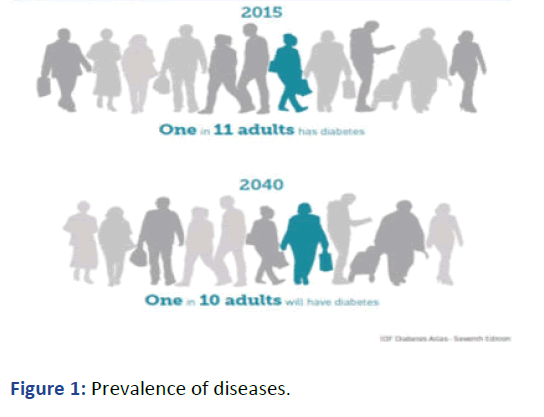
Figure 1: Prevalence of diseases.
What Happens in Diabetes?
The cells cannot take up glucose from the blood. Energy is
attempted to be provided from "fat" and "protein" since the
cells are unable to meet their energy needs. When 'fat' is used
as the energy source, the body's ketone levels rise [7]. The
patients experience fatigue and sluggishness when protein is
used as an energy source. Patients start to urinate more
frequently as a result of the kidneys' attempts to flush out
excess blood glucose when it is too high. The patients
experience thirst as a result and they begin to drink a lot. On
the other hand, patients still lose weight despite eating
frequently and in large amounts. There is often a long presymptomatic
phase before the diagnosis of type 2 diabetes.
The duration of glycemic burden is a strong predictor of
adverse outcomes (Figure 2) [8].
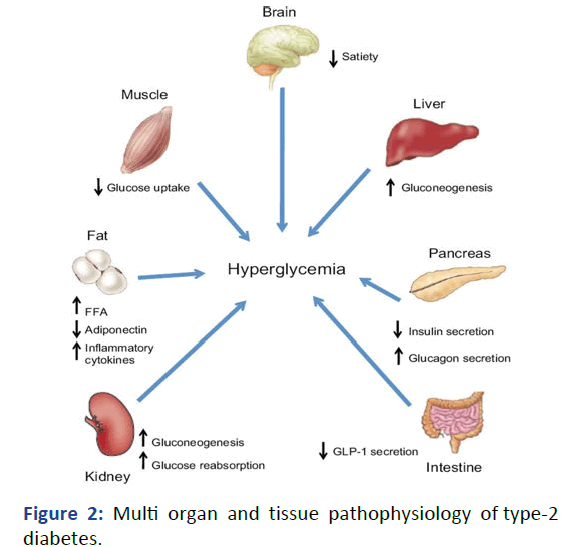
Figure 2: Multi organ and tissue pathophysiology of type-2
diabetes.
Types of Diabetes
Type 1 diabetes: Type 1 diabetes is usually diagnosed in
children and young adults. Only 10% of people with diabetes
have this form of the disease. In type 1 diabetes, the body
does not produce insulin. Patients with type 1 diabetes will
need to take insulin injections for the rest of their life. They
must also ensure proper blood-glucose levels by carrying out
regular blood tests and following a special diet.
Type 2 diabetes: The body does not produce enough insulin
for proper function or the cells in the body do not react to
insulin. Approximately 90% of all cases of diabetes worldwide
are of this type. Some people may be able to control their
type 2 diabetes symptoms by losing weight, following a
healthy diet, doing plenty of exercise and monitoring their
blood glucose levels. However, type 2 diabetes is typically a
progressive disease. It gradually gets worse and the patient
will probably end up having to take insulin.
Gestational diabetes: GDM is diabetes that is first diagnosed
in the second or third trimester of pregnancy. Test for
undiagnosed diabetes at the first prenatal visit in those with
risk factors, using standard diagnostic criteria [9].
The OGTT should be performed in the morning after an
overnight fast of at least 8 hours.
• The diagnosis of GDM is made if any of the following
criteria are met.
• Fasting plasma glucose ≥ 92 mg/dl 1-hour plasma glucose
≥ 180 mg/dl 2-hour plasma glucose ≥ 153 mg/dl.
At 24-28 weeks of gestation, pregnant women who have
never been diagnosed with diabetes should get tested for
gestational diabetes mellitus. At 4 to 12 weeks postpartum,
using the oral glucose tolerance test and clinically relevant
non-pregnancy diagnostic criteria, examine women with
gestational diabetes mellitus for persistent diabetes. Lifelong
screening for the onset of diabetes or prediabetes should be
performed at least every three years in women who have a
history of gestational diabetes mellitus [10,11].
How are Diabetes and Pre-Diabetes Diagnosed?
Blood tests are used to diagnose diabetes and pre-diabetes.
Lab analysis of blood is needed to ensure test results are
accurate. Glucose measuring devices used in a health care
provider’s office, such as finger-stick devices are not accurate
enough for diagnosis but may be used as a quick indicator of
high blood glucose.
Tests for blood glucose levels:
• Normal blood, results: A1C less than 5.7%; FPG less than
100 mg/dl; oral glucose tolerance test OGTT less than 140
mg/dl
• Pre-diabetes blood results: A1C 5.7% to 6.4%; FPG 100
mg/dl to 125 mg/dl; OGTT 140 mg/dl to 199 mg/dl
• Diabetes blood results: A1C 6.5% or higher; FPG 126 mg/dl
or higher; OGTT 200 mg/dl or higher (Figures 3 and 4).
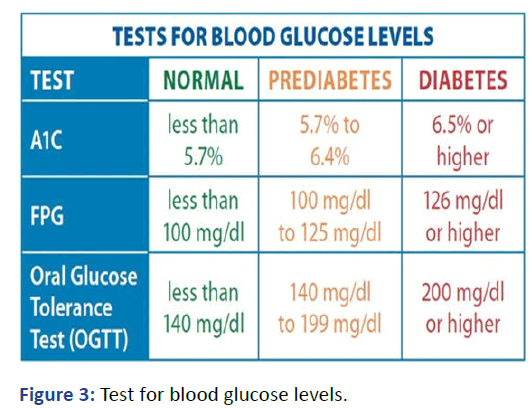
Figure 3: Test for blood glucose levels.
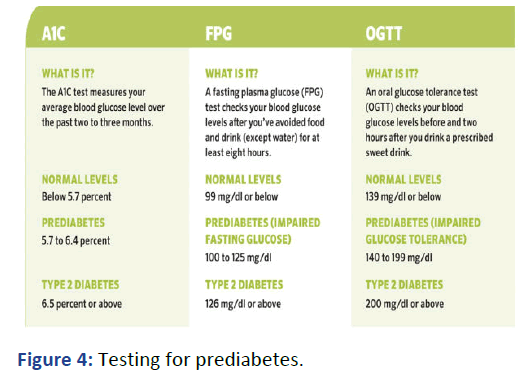
Figure 4: Testing for prediabetes.
Why do we Worry about Diabetes?
Diabetes is typically irreversible and acute metabolic
decompensation can cause death. Long-term metabolic
derangement is frequently accompanied by functional and
structural alterations in the body's cells, as well as secondary
harm to numerous organ systems, particularly the kidneys,
eyes, nerves and blood vessels (Figure 5) [12].
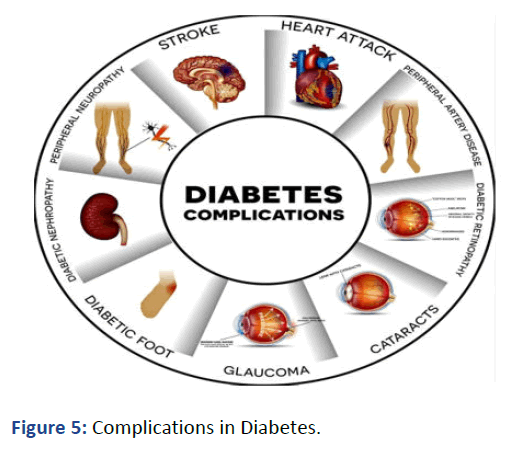
Figure 5: Complications in Diabetes.
Discussion
Categories of Increased Risk for Diabetes
Testing for prediabetes and risk for future diabetes in
asymptomatic people should be considered in adults of any
age who are overweight or obese (BMI ≥ 25 Kg/m2 or ≥ 23
Kg/m2 in Asian Americans) especially who have one or more
of the following risk factors:
• First degree relative with diabetes. High risk race.
• History of CVD. Hypertension: ≥ 40/90.
• HDL cholesterol level less than 35 mg/dl Triglyceride level
more than 250 mg/dl Women with polycystic ovary
syndrome Physical inactivity.
Patients with prediabetes (A1C, IGT and IFG) should be tested
yearly. Women who were diagnosed with GDM should
have lifelong testing at least every 3 years. For all other
patients testing should begin at age 45 years.
If results are normal, testing should be repeated at a
minimum of 3-year intervals, with consideration of more
frequent testing depending on initial results and risk status. At
least annual monitoring for the development of diabetes in
those with prediabetes is suggested. Patients with
prediabetes should be referred to an intensive
behavioral lifestyle intervention program modeled on
the diabetes prevention program [13].
How Can You Help Reduce Your Risk of Diabetes
Naturally?
Lifestyle interventions: Intensive lifestyle intervention
can reduce the incidence of type 2 diabetes by 58% over 3
years. The two major goals of lifestyle intervention are to
achieve and maintain a minimum of 7% loss of initial body
weight and increase moderate- intensity physical activity
(such as brisk walking) to at least 150 min/week.
Healthy diet plan: Daily nutritional needs should be taken
frequently but in small portions. Reducing caloric intake is
of paramount importance for those at high risk for
developing type 2 diabetes. The quality of fats consumed in
the diet is more important than the total quantity of dietary
fat. Healthy low calorie eating patterns should be encouraged.
The current standard diet for diabetic patients is a weight
reducing low fat low glycemic index diet with a reduction in
sodium content, however this needs to be modified according
to the individual state (body weight, ethnicity, diabetes
therapy and economic state). Carbohydrate intake
monitoring with carbohydrate counting or experience-based
estimation have been shown to improve glycemic control.
Nutrition advises specific to cardiovascular risk
reduction, avoidance of trans and saturated fats,
increased intake of fiber, intake of five or more servings of
fruits and vegetables daily and reduction of salt intake. This
advice should be provided to all patients. Smoking cessation
is critically important for persons with diabetes (Figures 6
and 7) [14].
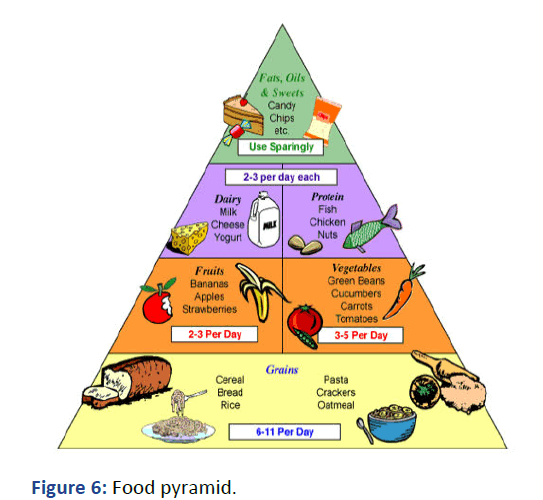
Figure 6: Food pyramid.
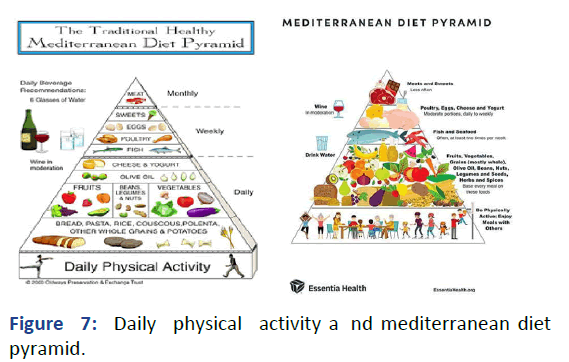
Figure 7: Daily physical activity a nd mediterranean diet
pyramid.
Weight reduction: Weight loss is recommended for all
overweight or obese individuals who have or are at risk for
diabetes. Weight loss has been shown to reduce insulin
resistance. Moderate weight loss (7% body weight) and
regular physical activity (150 min/week) with dietary
strategies are effective in reducing the progression from
prediabetes to diabetes.
Physical exercise: T2 DM patients should be encouraged to
perform moderate intensity aerobic exercise at least 150 min.
per week (50% to 70% of maximum heart rate) and resistance
training 3 times/week in the absence of contraindications.
Health care providers should assess the level of physical
activity in diabetic patients and provide encouragement to
reach the target of exercise weekly. Physical limitations should
be addressed and alternative exercise programs developed as
needed (Figure 8) [15].
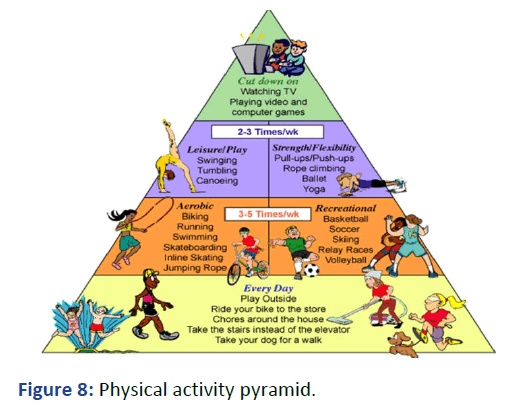
Figure 8: Physical activity pyramid.
Advantages of exercise:
• Benefits of glycemic control
• Improves insulin sensitivity
• Builds physical fitness
• Optimizes body weight
• Gives psychological wellbeing
Disadvantages:
• Carry some risk
• Strains the compromised CVS
• Injuries to musculoskeletal system
• Predisposes to hypoglycemia
• May exacerbate complications
Contraindications:
• Diabetic ketosis
• Diabetic retinopathy
• Renal dysfunction
• CVS disease
• Foot ulcers
Precautions:
• Choose suitable footwear
• Comfortable loose clothes
• Close foot inspection every day
• Snacks as protection from hypoglycemia
• Select the proper exercise program
Patients should be able to carry out a normal conversation
while exercising without getting breathlessness.
Diabetes at school:
• Brochures and films should be prepared to inform the
students about diabetes.
• Students should be informed about the importance of
healthy eating and doing exercises.
• School canteens should be controlled to sell healthy food
and healthy drinks rather than fast food and fizzy drinks.
• Students should be informed about not eating fast food.
• Parents should be informed about healthy nutrition and
the importance of homemade food in children's bags.
• Teachers should observe their students and their health
problems. If they have some symptoms of any diseases,
they should contact the parents.
• They also should inform the students about the
importance of their health [16].
Conclusion
People with type 1 diabetes should be treated with multiple
daily injections of prandial and basal insulin or continuous
subcutaneous insulin infusion. Prefer to use rapid acting
insulin analogs to reduce hypoglycemia risk. Consider
educating adult individuals on matching prandial dose of
insulin according to meal, premeal blood glucose level and if
performing physical activity. Your body needs the right fuel to
help it work well. Get moving, find something you enjoy.
References
- Amin N, Doupis J (2016) Diabetic foot disease: From the evaluation of the “foot at risk” to the novel diabetic ulcer treatment modalities. World J Diabetes. 7(7):153.
[Google Scholar]
- Dhaliwal G, Mukherjee D (2007) Peripheral arterial disease: Epidemiology, natural history, diagnosis and treatment. Int J Angiol. 16(2):36.
[Crossref] [Google Scholar] [PubMed]
- Ayodele OE, Alebiosu CO, Salako BL (2004) Diabetic nephropathy: A review of the natural history, burden, risk factors and treatment. J Natl Med Assoc. 96(11):1445.
[Google Scholar] [PubMed]
- Nyenwe EA, Jerkins TW, Umpierrez GE, Kitabchi AE (2011) Management of type 2 diabetes: Evolving strategies for the treatment of patients with type 2 diabetes. Metabolism. 60(1):1-23.
[Crossref] [Google Scholar] [PubMed]
- Rahmathulla G, Marko NF, Weil RJ (2013) Cerebral radiation necrosis: a review of the pathobiology, diagnosis and management considerations. J Clin Neurosci. 20(4):485-502.
[Crossref] [Google Scholar] [PubMed]
- Olokoba AB, Obateru OA, Olokoba LB (2012) Type 2 diabetes mellitus: A review of current trends. Oman Med J. 27(4):269-273.
[Crossref] [Google Scholar] [PubMed]
- Sloan G, Selvarajah D, Tesfaye S (2021) Pathogenesis, diagnosis and clinical management of diabetic sensorimotor peripheral neuropathy. Nat Rev Endocrinol. 17(7):400-420.
[Google Scholar]
- Basem JI, Bah FN, Mehta ND (2023) A Brief Review on the novel therapies for painful diabetic neuropathy. Curr Pain Headache Rep. 12(7):1-7.
[Google Scholar]
- Shih K, Lam KS, Tong L (2017) A systematic review on the impact of diabetes mellitus on the ocular surface. Nutr Diabetes. 7(3):251.
[Crossref] [Google Scholar] [PubMed]
- Ferguson BJ, Mitchell TG, Moon R, Camporesi EM, Farmer J (1998) Adjunctive hyperbaric oxygen for treatment of rhinocerebral mucormycosis. Rev Infect Dis. 10(3):551-559.
[Google Scholar]
- Jang J, Colletti AA, Ricklefs C, Snyder HJ, Kardonsky K, et al. (2021) Implementation of app-based diabetes medication management: Outpatient and perioperative clinical decision support. Curr Diab Rep. 21:1-9.
[Crossref] [Google Scholar] [PubMed]
- Ofosu A, Ramai D, Reddy M (2018) Non-alcoholic fatty liver disease: Controlling an emerging epidemic, challenges, and future directions. Ann Gastroenterol. 31(3):288.
[Google Scholar]
- Buzzetti R, Maddaloni E, Gaglia J, Leslie RD, Wong FS, Boehm BO (2022) Adult-onset autoimmune diabetes. Nat Rev Dis Primers. 8(1):63.
[Crossref] [Google Scholar] [PubMed]
- Vileikyte L (2021) Diabetic foot ulcers: A quality of life issue. Diabetes Metab Res Rev. 17(4):246-249.
[Crossref] [Google Scholar] [PubMed]
- Morpeth JF, Bent III JP, Kuhn FA, Rupp NT, Dolen WK (1996) Fungal sinusitis: an update. Ann Allergy Asthma Immunol. 76(2):128-140.
[Crossref] [Google Scholar] [PubMed]
- Pantalone KM, Wells BJ, Chagin KM, Ejzykowicz F, Yu C, et al. (2016) Intensification of diabetes therapy and time until A1C goal attainment among patients with newly diagnosed type 2 diabetes who fail metformin monotherapy within a large integrated health system. Diabetes Care. 39(9):1527-1534.
[Crossref] [Google Scholar] [PubMed]
Citation: Hawal AIM, Hegab WMS, Hussin FET, Gad SMH, Mohamed GIM, et al. (2023) Natural Management Modalities in a
Newly Diagnosed Diabetic Patient: J Diab Res Endocrinol. 7:22.
Copyright: © 2023 Hawal AIM, et al. This is an open-access article distributed under the terms of the Creative Commons
Attribution License, which permits unrestricted use, distribution, and reproduction in any medium, provided the original author
and source are credited.
